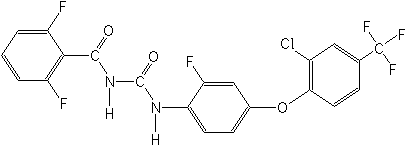|
Return to
Adverse Effects
Abstracts
ACTIVITY:
Acaricide,
Insecticide (Benzoylurea)
CAS Name:
N-[[[4-[2-chloro-4-(trifluoromethyl)phenoxy]-2-fluorophenyl]amino]carbonyl]-2,6-difluorobenzamide
Structure:

Adverse
Effects:
Blood
Bone
Endocrine:
Adrenal
Endocrine: Ovary
Endocrine:
Testicular
Endocrine: Thyroid
Kidney
Liver
Spleen |
| Environmental
Effects:
Persists
in soil
Extremely
toxic to Daphnia (Aquatic Invertebrate)
Potential
to bioaccumulate in fish and aquatic gastropods |
Regulatory
Information
(only comprehensive for the US) |
| US
EPA Registered: |
YES
(for certain imports) |
| US
EPA PC Code: |
108203 |
Registered
use in
(includes only a limited list of countries)
|
Australia,
Hungary, India, Japan, Philippines, Portugal, Tanzania, South
Africa, US, Vietnam |
| US |
Imported--
Apple, Cattle, Goat, Grape, Horse, Milk, Orange, Pear, Raisin,
Sheep |
| Japan's
Maximum Residue Levels (MRLs) |
Apple,
Brussel Sprouts, Cabbage, Celery, Cherry, Cotton seeds, Cucumber,
Eggplant, Grape, Grapefruit, Multiplying onion (inc Shallot),
Lemon, Lime, Melons, Mushrooms (other than Shitake or Button),
Natsudaidai (whole), Other Citrus fruits, Orange, Peach, Japenese
pear, Pear, Radish (Japanese), Strawberry, Sugar beet, Tea,
Tomato, Unshu orange, Welsh (inc Leek)
--
Note
very high levels - 15 ppm - in
Tea (Green, Black, Oolong, Wulung) |
| Other
Information |
| Molecular
Formula: |
C21H11Cl
F6 N2O3 |
| Entry
Year: |
1993 |
| Manufacturers: |
SOREX,
Cyanamid,
BASF |
| Other
Names: |
Casade,
Europe, Sigona,
Tenopa, WL-115110 |
| Manufacture
site: |
FRANCE:
SNPE,
Toulouse |
| Of
special interest: |
| PAN
Data |
| September
2006: USEPA Fact
Sheet on flufenoxuron. |
August
15, 2006. US EPA Human
Health Risk Assessment for proposed tolerances on apples,
pears, grapes, organges and livestock commodities
imported into US. 63 pages.
METABOLITES & DEGRADATES:
2,6,-difluorobenzoic acid
2,6,-difluorobenzamide
4-(2-chloro,á, á, á trifluoro-p-tolyoxy)-2-fluorophenyl
urea (WL129183)
4-(2-chloro,á, á, á rifluoro-p-tolyoxy)-2-fluoroaniline
(WL15096)
• The database is adequate
for establishment of tolerances on the requested commodities,
except for a developmental toxicity
study in rat which was classified as unacceptable/guideline.
However, this study provides adequate information to conclude
that flufenoxuron was not fetotoxic at doses up to the limit
dose. Only an acute oral toxicity study in rat was submitted,
which was placed in Toxicity Category IV. Acute
toxicity studies are not required for import tolerance. |
| December
1995 - Evaluation of Flufenoxuron
use as a public hygiene insecticide. UK:
Health and Safety Executive, Biocides & Pesticides Assessment
Unit, Magdalen House, Stanley Precinct, Bootle, Merseyside L20
3QZ. Available at http://www.pesticides.gov.uk/citizen/evaluations/143_confirm-box.htm |
| Abstracts |
| Glossary
of Pesticide Chemicals,
October 2001. A listing of pesticides subject to analysis of
residues in foods and feeds by the US Food and Drug Administration. |
| Active
ingredient in TENOPA-- Data Safety
Sheet at http://www.sorex.com/site/home.htm |
| European
Union: Rapid Alert System for Food and Feed
Alert
Notifications are sent when the food or feed presenting the
risk is on the market and when immediate action is required.
Alerts are triggered by the Member State that detects the
problem and has initiated the relevant easures, such as withdrawal/recall.
The notification aims at giving all the members of the network
the information to verify whether the concerned product is
on their market, so that they also can take the necessary
measures.
The following
information was released in June 2005 - see
http://europa.eu.int/comm/food/food/rapidalert/reports/week23-2005_en.pdf
|
| Date: |
Notified
By: |
Ref: |
Reason
for Notifying |
Country
of Origin: |
| 03/06/2005 |
Germany |
2005.BND |
flufenoxuron
in sultanas |
TURKEY |
| |
| Published
date |
Docket
Identification Number |
Details |
| September 29, 2006 |
EPA-HQ-OPP-2005-0543 |
BASF.
Pesticide
Tolerance. FINAL
RULE.
FIRST-TIME TOLERANCE
| Commodity |
PPM
FINAL RULE |
| Apple\1\ |
0.50 |
| Cattle,
fat\1\ |
4.5 |
| Cattle,
meat\1\ |
0.10 |
| Cattle,
meat byproducts\1\. |
0.50 |
| Goat,
fat\1\. |
4.5 |
| Goat,
meat\1\ |
0.10 |
| Goat,
meat byproducts\1\ |
0.50 |
| Grape\1\ |
0.70 |
| Grape,
raisin\1\ |
2.0 |
| Horse, fat\1\ |
4.5 |
| Horse,
meat\1\ |
0.10 |
| Horse,
meat byproducts\1\ |
0.50 |
| Milk |
0.20 |
| Milk,
fat\1\ |
4.0 |
| Orange\1\
|
0.30 |
| Orange,
oil\1\ |
60 |
| Pear\1\ |
0.50 |
| Sheep,
fat\1\ |
4.5 |
| Sheep,
meat\1\ |
0.10 |
| Sheep,
meat byproducts\1\ |
0.50 |
| \1\There
are no U.S. registrations as of September 30, 2006. |
• August
15, 2006. US EPA Human
Health Risk Assessment for proposed tolerances on apples,
pears, grapes, organges and livestock commodities imported
into US. 63 pages.
• September 2006: USEPA Fact
Sheet on flufenoxuron.
|
| April 19, 2006 |
EPA-HQ-OPP-2005-0543 |
BASF.
Pesticide
petition: PP 8E4943.
in or on food commodities
-- apple and pear at 1.0 ppm
-- orange at 0.3 ppm
-- orange oil at 60.0 ppm
-- grape at 0.2 ppm
-- raisin at 0.8 ppm
-- cattle meat at 0.30 ppm
-- cattle meat by-products at 1.5 ppm
-- fat at 6.0 ppm
-- milk at 0.6 ppm
-- milk fat at 3.0 ppm |
| |
|
|
|